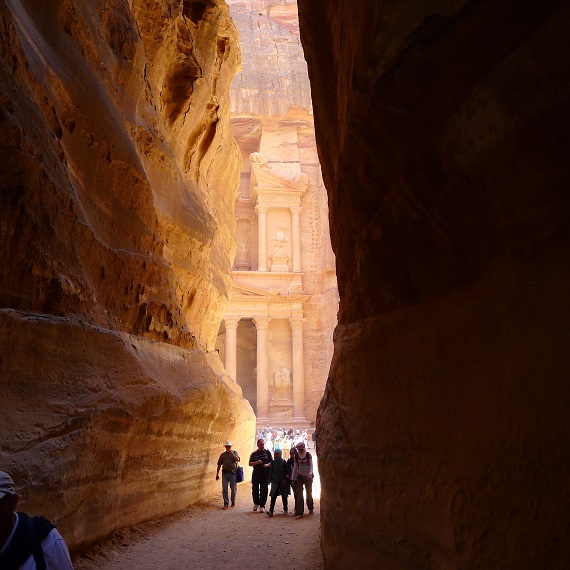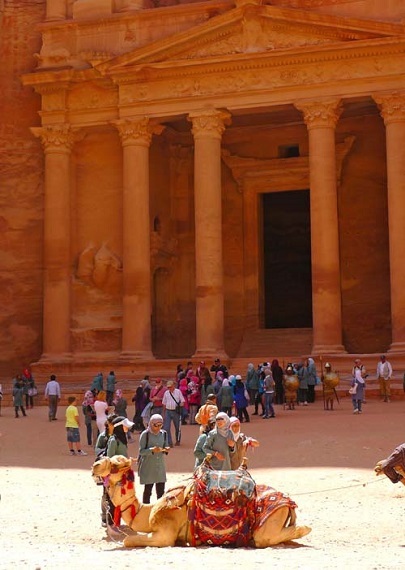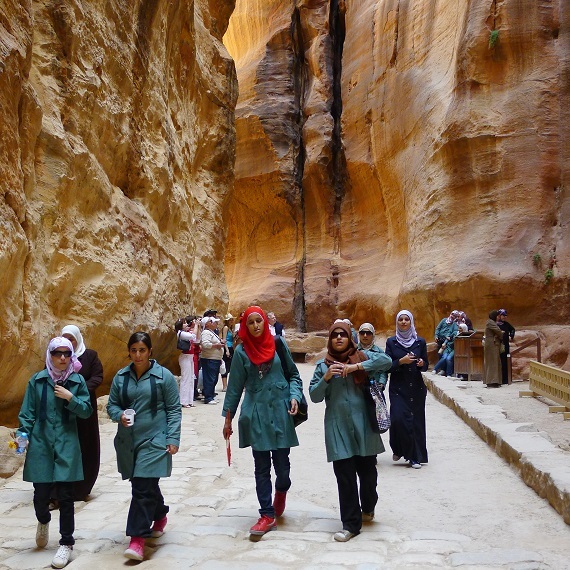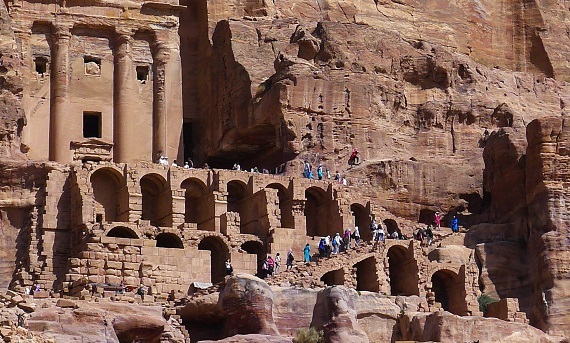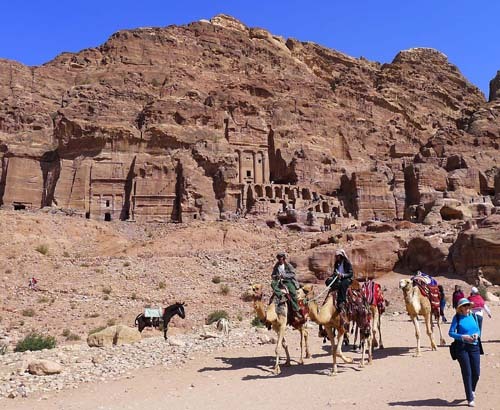The poet could have hopped on a camel at his home in Sidon, plodded off south down the Phoenician (now Lebanese) coast, headed inland past Jerusalem and reached the Nabataean capital at Petra - depending on the traffic - in a couple of days. There, he could have batted off a few odes to the glories of this world-class trading crossroads, which thousands of years later would be immortalized in the movie, Indiana Jones and the Last Crusade.
(Around 140 B.C., the poet beat Indiana to the punch when it came to immortalizing wondrous cities. Seven of them, actually. More about that later.)
The trip might have taken a day or so longer had the poet run into heavy traffic coming his way, like half-mile-long caravans loaded with silks, frankincense, myrrh, spices and slaves from China, India and Southern Arabia. Trade routes from these places took the caravans to the regional hub at Petra, from which they headed west to Sidon and other ports along the Mediterranean coast to be loaded on ships sailing off to Egypt, Greece, Rome and Spain.
Why Petra? About 2,500 years ago, Nabataean nomads decided to settle down here, most likely when they found the place was easy to defend, thanks to a labyrinth of steep canyon walls, and was blessed with lots of water. In exchange for protection, water and a time-out for rest and relaxation, the caravans paid taxes to the Nabataeans, making Petra one of the wealthiest cities of the ancient world. The good times lasted until the early 2nd century A.D., when the city was absorbed into the Roman empire became part of the Roman province of Arabia.
Fast-forward to today, and tourists are in for big surprise at Petra. "Many visitors think the cliffside 'Treasury' building they've seen so often on travel posters and in the Indiana Jones movie is the only thing that's there," says tour guide Mahmoud Iwaissi. "True, there's nothing else quite like (that building) in the world, but it's only the start of the thrills waiting for them at Petra."
Whatever you've seen or heard about Petra, nothing really prepares you for the immense size of the city - it's big enough to cover New York's Manhattan Island, although mostly not excavated yet - or the hundreds, perhaps thousands, of structures carved into the sandstone, from tombs to baths, churches, shrines and temples. And if you're up to climbing 900 stairs, a towering monastery awaits you atop the cliffs.
Getting to the Treasury isn't easy. Slip on your knockoff Nikes for a mile-long trek over a winding, stone-studded trail through a narrow gorge -- sometimes only 10 feet wide -- flanked on both sides by soaring cliffs as high as 30-story buildings. You'll find the Treasury in a large rest area full of tourists snapping images of the 130-foot-high hillside building (it's actually only a facade) and noshing down at snack bars.
From there it's another mile to the end of the main site. Considerably wider than the first part of the trail, the second part is dotted by hillside tombs, temples and the like, giving tourists ample chances to go scampering through the ruins and also a partially restored 3,000-seat amphitheater.
Now, back to the poet. His name was Antipatros Sidonios, and chances are you never heard of him (not even by his nickname, the Antipater of Sidon). But anyone who's read a history book over the last 2,100 years likely knows about a famous list put together by this bard. A sort of guide to the world's top attractions at the time, he published it in a short piece of prose:
"I have set eyes on the wall of lofty Babylon on which is a road for chariots, and the statue of Zeus, and the hanging gardens, and the Colossus of the Sun, and the huge labour of the high pyramids, and the vast tomb of Mausolus; but when I saw the house of Artemis that mounted to the clouds, those other marvels lost their brilliancy...'"
From this came the timeless Seven Wonders of the Ancient World. (Actually, Sidonious only named six. The seventh - the Lighthouse of Alexandria - was added later. Perhaps Cleopatra had a good PR man.)
Many historians believe Petra should have been on the original list of Wonders as well. But for some reason it didn't strike the poet's fancy.
Tour guide Iwaissi notes Petra is much closer to Sidon than the Egyptian pyramids, Babylon's hanging gardens, western Turkey's temple of Artemis and the other ancient wonders in Sidonios' poem. "Petra was one of the hot spots of the world in Sidonios' day...he must have been there."
Petra made the headlines again in 1985 when the city was named a World Heritage Site by the United Nations' Educational, Scientific and Cultural Organization, or UNESCO. Then, in 2007 Petra finally made the big time in global tourism: It was voted one of the New 7 Wonders of the World.
Photos by Bob Schulman
